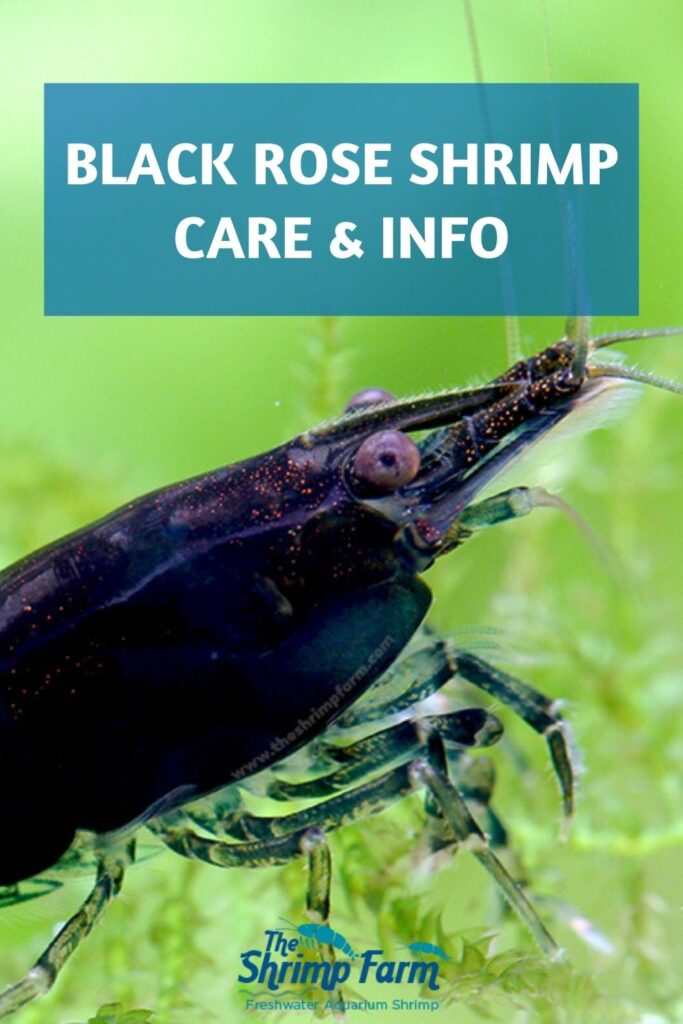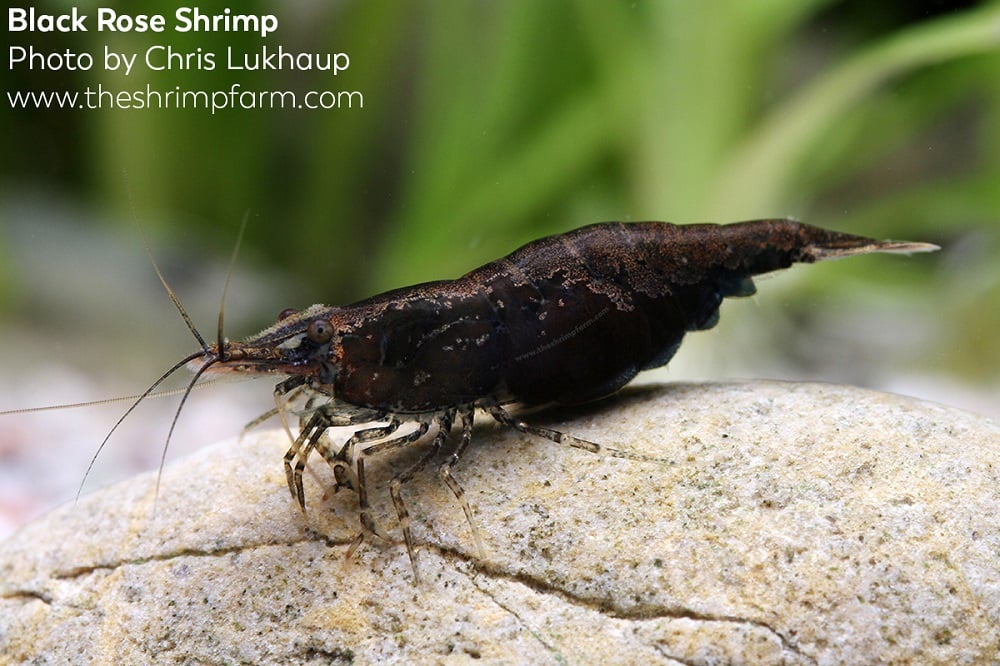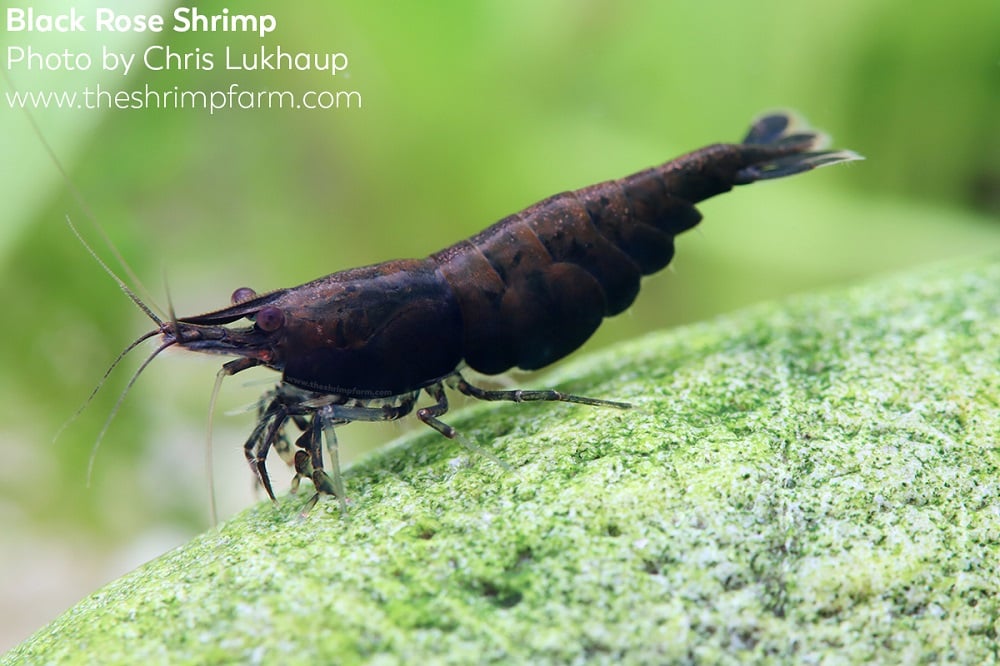Black rose shrimp (Neocaridina davidi var. "Black Rose")
Looking for a shrimp that's as easy to keep as a cherry shrimp, and as jet black as the stunning but fragile black king kong Caridina variety? Let us introduce you to the black rose shrimp. Easily one of the most spectacular Neocaridina davidi varieties, it makes a great choice for beginners who aren't ready for more difficult shrimp but still want something unusual.
Keep reading for everything you need to know about keeping black rose shrimp in your own aquarium.
| Scientific name | Neocaridina davidi var. "Black rose" |
| Common names | Black rose shrimp |
| Difficulty level | Easy |
| Origin | Taiwan |
Table of Contents
Black rose shrimp requirements
Black rose shrimp requirements are similar to those of other Neocaridina davidi varieties. To get started, you'll need an aquarium of at least 5 gallons. Larger is better in most cases and lessens the chances of water quality issues.
Cycle your tank so it's shrimp-safe. A sponge filter or any other type of filter with a filter guard works well for this purpose. A heater is not a must but still recommended in most cases, as it keeps the water temperature stable even if room temperatures swing.
Decor-wise, you can keep it simple or go all out, as long as you provide at least some hiding places. Live plants work very well and will really be appreciated by your (baby) shrimp as hides and foraging spots. There are also plenty of shrimp tubes and caves on the market that provide shelter. Even something as simple as a moss ball can help your shrimp feel safe!
Water quality
Even though black rose shrimp can be classed as one of the hardier dwarf shrimp varieties, they still require high water quality. Never introduce black rose shrimp into your tank if you're not sure whether it's completely cycled. Avoid any sudden swings in water values in temperature and keep nitrates low (<10 should be fine). Remember that stability is more important than getting the water values exactly right.
You can keep your water quality high by performing regular aquarium maintenance. For starters, do weekly water changes. Test the water regularly even if nothing seems wrong, and remove anything that might cause issues immediately (leftover food, dead tankmates, etc.).
pH: 6.2-8.0
Temperature: 65-85 °F
GH: 4-8
KH: 3-15
Total Dissolved Solids: 150-200
Tankmates
Black rose shrimp are a good choice if you're interested in keeping your shrimp with some tankmates, as they breed relatively quickly. Do keep in mind that no fish is entirely shrimp safe. Some fry can always end up disappearing. If that's not an issue for you, you can consider small and peaceful microfish species.
Dedicated breeders usually prefer to keep their tanks free of fish and go invertebrate only, dwarf shrimp only or even single species with their tanks. This helps prevent any stress, overcrowding or competition for food and thus helps guarantee the highest survival rates possible.
Diet
Like most shrimp, black rose shrimp are bottom feeders that will happily consume almost anything. They have a particular love for biofilm, but because our aquariums are usually too 'clean' to contain enough of it, you'll have to feed them a little extra.
Use a high-quality shrimp food as a staple. On top of that, add some variation by letting algae grow on decorations/one of the aquarium panes, feeding blanched veggies, tossing in some leaf litter or offering some of the many other 'homemade shrimp foods' you can choose from.
Breeding black rose shrimp
Breeding black rose shrimp is similar to breeding the popular red cherry shrimp: very easy. Neocaridina davidi varieties are quite prolific, after all. If you have breeding age shrimp of both sexes, the females should be pregnant almost constantly.
Since you can't really see a black rose's saddle due to the dark coloration, you won't know for sure whether a female is carrying eggs until they are fertilized and she moves them to her swimmerets (back legs). She keeps them there for around 30 days, continuously supplying them with fresh water until they hatch into tiny baby shrimp. You can feed the babies using powdered food, although unless your aquarium is squeaky clean, they should usually be able to find enough to eat on their own.
If your dwarf shrimp aren't breeding, be sure to check if you have both males (usually smaller) and females. Keep a close eye on your water values and make sure you're feeding a proper diet that contains plenty of calcium, which prevents failed molts.
Buying black rose shrimp
When we first published this care guide, the black rose shrimp was still a very new addition to the aquarium hobby and was difficult to find. Things have improved a lot now, although most local aquarium stores are still unlikely to carry the species. They may be able to order a few in for you, or you could turn to the internet: The Shrimp Farm sells homebred black rose shrimp with live arrival guarantee.



 Shrimp
Shrimp Fish
Fish Crab &
Crab & Plants
Plants Foods
Foods Snails
Snails



What are your prices like?
What is your water quality?
And how long for delivery?
Payment method?